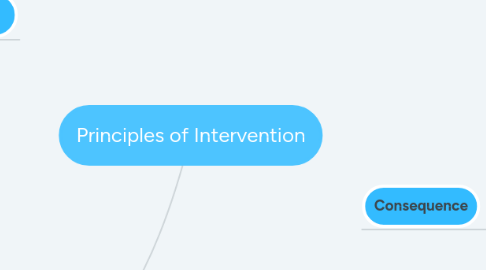
1. Behavior
1.1. BEHAVIOR IS STRENGTHENED, WEAKENED, OR MAINTAINED BY MODELING
1.1.1. vicarious reinforcement
2. Antecedent
2.1. WHAT IS CAUSING THE BEHAVIOR?
2.2. WHAT DO WE KNOW ABOUT WHAT MOTIVATES THE BEHAVIOR?
2.3. ONCE WE KNOW WHAT TRIGGERS THE BEHAVIOR AND MAINTAINS IT, WE CAN WORK TO PREVENT IT
2.3.1. Differential Reinforcement
2.4. Plan to provide non contingent reinforcements or plan for desired rewards for known challenging situations
3. Consequence
3.1. BEHAVIOR IS CONTROLLED BY ITS CONSEQUENCES
3.1.1. stimulus control
3.1.1.1. discriminatory stimulus
3.1.2. shaping
3.2. BEHAVIOR IS STRENGTHENED OR MAINTAINED BY REINFORCEMENT
3.2.1. positive reinforcement
3.2.1.1. How do we know what is reinforcing and what is punishing for a student?
3.2.2. negative reinforcement
3.2.3. escape and avoidance behaviors
3.2.3.1. What is the difference between these two phrases?
3.2.3.2. If you are not quiet, and follow the rules, then you are not going to get the sweatshirt.
3.2.3.3. If you follow the rules, you get the sweatshirt at the end of the month. If you don't follow the rules, you do not get it.
3.3. BEHAVIOR IS WEAKENED BY WITHHOLDING THE CONSEQUENCES THAT HAVE MAINTAINED IT
3.3.1. extinction
3.3.1.1. extinction burst
3.3.2. What behaviors would not be a fit with extinction?
3.3.3. Differential Reinforcement (combines reinforcement with extinction)
3.3.3.1. DRI
3.3.3.1.1. Incompatible
3.3.3.2. DRO
3.3.3.2.1. Other
3.3.3.3. DRA
3.3.3.3.1. Alternative
3.3.3.4. DRL
3.3.3.4.1. Low Rates
3.3.4. Time out
3.3.4.1. Contingent observation - student remains in position to observe the group without participating or receiving reinforcement for a period of time
3.3.4.2. Planned ignoring - ties with extinction; withholding social attention during time out period
3.4. punishment - either present an aversive consequence or remove a desired consequence or reward (not what is maintaining behavior)
3.4.1. Seclusionary Timeout - removed from setting, to another room
3.4.2. Exclusionary Timeout - being physically excluded from on ongoing activity - in a chair away from a group; does not have to be exclusion from reinforcement (i.e., could be sitting out during circle time or during an activity)
3.4.3. Response Cost - loss of a reinforcer; reinforcer is taken away and not withheld; is not the function of behavior
3.4.3.1. i.e., loss of token, privilege, recess, points
3.4.4. Positive Practice Overcorrection - students repeats selected behaviors to practice the "right way" i.e. walking to the door three times after running
3.4.5. Restitutional Overcorrection - student overcorrects effects of behavior on environment; cleans her desk and the desks of others in the room
3.5. BEHAVIOR IS WEAKENED BY PUNISHMENT
3.6. TO EFFECTIVELY INFLUENCE BEHAVIOR CONSEQUENCES MUST CONSISTENTLY AND IMMEDIATELY FOLLOW THE BEHAVIOR THEY ARE MEANT TO CONTROL
3.6.1. contingency
3.6.1.1. When do you want to give reinforcement without it being contingent on seeing a behavior first?
4. Must examine the intrusiveness and the restrictiveness of any intervention
4.1. Intrusive - extent to which interventions impinge or encroach on students' bodies or rights; degree they interrupt regular education activities
4.2. Restrictiveness - extent to which an intervention inhibits students' freedom to be treated like all other pupils
4.3. Work to avoid allowing the student to live up to his/her reputation
4.3.1. Treat student as you would your best student
